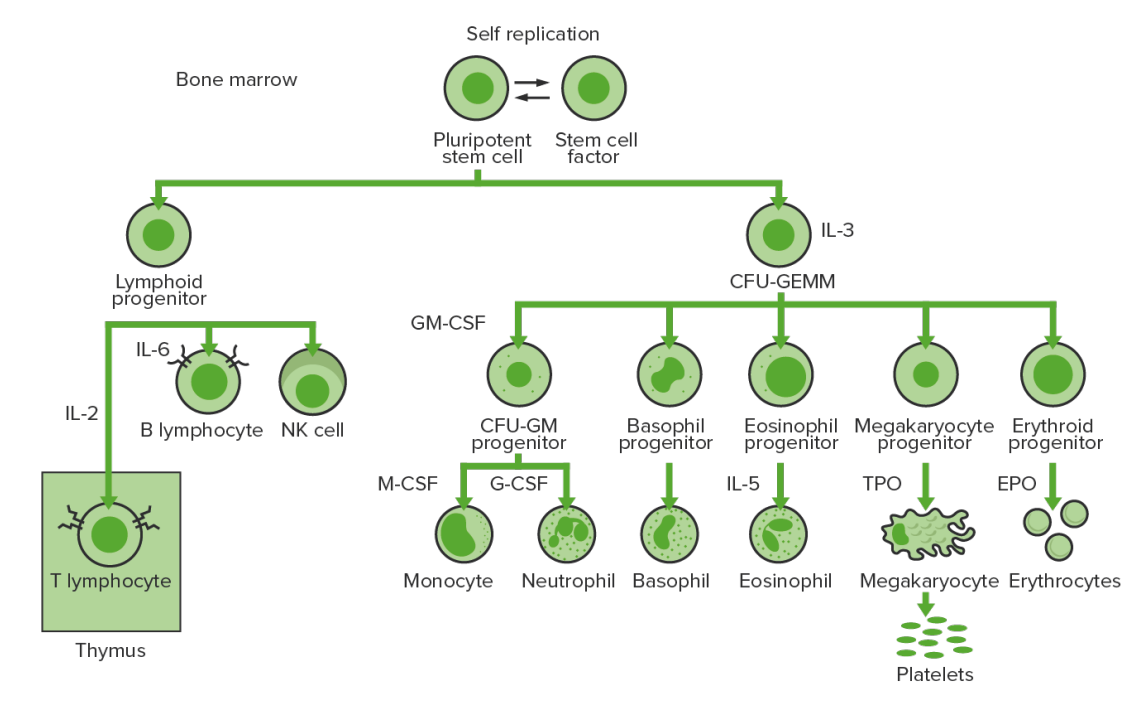Playlist
Show Playlist
Hide Playlist
Blood Structure – Blood Formation
-
Slides Anatomy of the blood.pdf
-
Download Lecture Overview
00:01 Now, let's just consider the environment in which this hemapoiesis takes please and specifically consider the stem cell niche. 00:12 Blood is made in the bone marrow. 00:15 We don't know why this evolved, but it seems to be a highly effective strategy for the generation of blood. 00:22 Now, hemapoietic bone marrow or bone marrow that's making blood is present in almost all bones in children. 00:30 But as we get older it gets more restricted. 00:33 It's in our vertebra, our pelvis, and then in our proximal long bones. 00:39 And stem cells are supported within the bone marrow in a niche or micro environment. 00:46 We can have a closer look at that on the right. 00:49 On the top right we see the bone, the cortical bone and up against it, the top right of the stem cells, the progenitor cells. 01:00 And bone cells such as osteoblast directly support the survival of hemapoietic stem cells. 01:09 As the stem cells give rise to hemapoiesis, we see waves of differentiated hemapoietic cells which flow through the bone marrow and into that gray central longitudinal vein and you'll see on that diagram, hemapoietic islands and erythropoietic islands of hemapoiesis. 01:31 You'll see just to the bottom there, a megakaryocyte, a very large cell with multiple nuclei that's releasing platelets into the central longitudinal vein. 01:44 And on the right, we'll see some of the cells that support bone marrow function. 01:50 Adipocytes or fat cells, they comprise a great proportion of the bone marrow and if you take a biopsy of the bone marrow you'll see a lot of empty space occupied by fat cells. 02:03 And just at the bottom right, the extracellular matrix fibers which provide the structural support for the bone marrow and also bind molecules such as chemokines which are critical in guiding the migration of cells in and out of the bone marrow. 02:24 I want to finish this lecture by talking about the structure of the spleen which is a fascinating organ. 02:30 Normally, under your left ribs you shouldn't feel your spleen, it's well tucked away. 02:35 This consists of two major types of tissue -- the red pulp and the white pulp. 02:43 The red pulp is where the red cells in our blood undergo a quality control and I'll explain that in a minute, whereas, the white pulp is part of our immune system. 02:55 And the spleen has a very important role in scanning the blood for evidence of bacterial infection. 03:03 Now the blood system in the spleen is really quite fascinating because it has a unique open system in which it's not contained within capillaries. 03:13 Let me explain. 03:15 Look at that diagram on the right. 03:18 At the bottom we have the blood coming in through the trabecular artery and in to the central artery. 03:26 And around it you'll see lots of lymphocytes. 03:31 It's coded there as PALS, the periarterial lymphatic sheath. 03:37 That's a massive lymphoid tissue which is screening the blood for the presence of bacteria and starting and initiating antibody responses against those. 03:49 That's a good example of the white pulp activity of the spleen. 03:54 But those arteries going to capillaries which breakdown and lose their wall structure and red cells end up in things called venous sinuses which you can see represented higher up in this structure. 04:11 Here, red cells, very slowly migrates in very large sinuses in the presence of many macrophages. 04:20 The macrophages scan the red cells for any evidence of dysfunction or residual bits of iron from their release from the bone marrow and they remove old, and damaged red cells from the blood. 04:34 Finally, these red cells now clear, and the healthy ones are released back into the splenic vein and into the blood system, so it's a very remarkable open system of blood circulation within the spleen. 04:51 So in summary, we've seen in this lecture, blood cells are derived from red stem cells within the bone marrow. 05:00 A wide range of different cell types are made which help to carry oxygen, fight infection, and repair damaged blood vessels. 05:09 As we shall see, inherited or acquired disorders can affect any of these different cells and lead to a wide range of different clinical complications. 05:21 I hope you've enjoyed this introduction to blood.
About the Lecture
The lecture Blood Structure – Blood Formation by Paul Moss, PhD, OBE, FMed, FRCPath is from the course Hematology: Basics.
Included Quiz Questions
Which of the following is not usually found in the spleen?
- Hematogones
- Red pulp
- White pulp
- PALS
- Venous sinuses
What area of the bone houses hemopoietic stem cells?
- A "niche" near the cortical bone
- The Haversian canal
- The lamellar bone
- The adipocytes
- The trabeculae
Customer reviews
5,0 of 5 stars
| 5 Stars |
|
2 |
| 4 Stars |
|
0 |
| 3 Stars |
|
0 |
| 2 Stars |
|
0 |
| 1 Star |
|
0 |
Hi. This is a great idea for prelecture for medstudents. Thank you.
good becoz it will definitely help me in my up coming exam of ut-3 thanks Dr. Paul Moss




